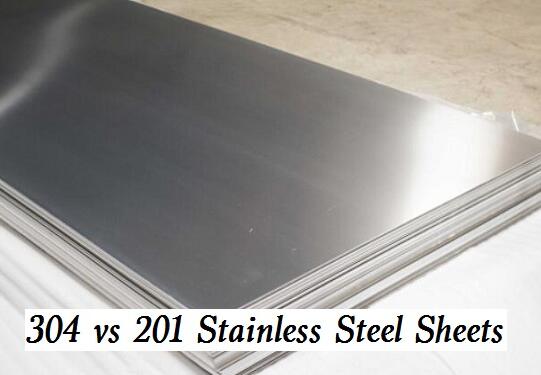Stainless steel is one of the most common materials in sheet metal manufacturing services. Various types of stainless steel grades can form metal plates and be used for different purposes. Speaking of 304 and 201 stainless steel plates, what is the difference and how to distinguish it?

1.Price: commonly used stainless steel plates are divided into different grades, including SS201 and SS304. They have different ingredients. In general, 304 stainless steel plate is more expensive than 201 plate. 201 stainless steel is generally considered as a substitute for 304. .
2. Application: 201 is a substitute for 301 steel. It is magnetic after cold working and is used for railway vehicles. Stainless Steel Sheet Grade 304 is the most widely used stainless steel and heat-resistant steel. Used for food production equipment, general chemical equipment, nuclear energy and so on.
3. Composition: 201 plate has high manganese content, bright and dark surface, high manganese content and easy to rust. 304 contains more chromium, the surface is matte and does not rust. Another major difference between 201 and 304 is the content of nickel. .
4. Corrosion resistance: the most important thing is different corrosion resistance. 201 metal sheet has poor corrosion resistance, so the price is much cheaper. Because the content of 201 nickel is low and the price is lower than 304, the corrosion resistance is not as good as 304. The content of alloy elements, generally speaking, when the chromium content is 10.5%, the steel is not easy to rust. The higher the content of chromium and nickel, the better the corrosion resistance. For example, 304 material has a nickel content of 8-10% and a chromium content of 18-20%. This kind of stainless steel will not rust under normal circumstances.
5. Mechanical properties: 201 stainless steel has high hardness, but its toughness is not as good as 304. 304 has better anti-fatigue performance.
6. Color: 201 has high manganese content, bright and dark surface, high manganese content and easy to rust. 304 contains more chromium, the surface is matte and does not rust.
7. Other: stainless steel is not easy to rust, because the surface of the steel body is rich in chromium oxide, which can protect the steel body. Sheet metal 201 is a high manganese stainless steel with higher hardness than 304, high carbon and low nickel.
How to distinguish between 304 and 201 in stainless steel sheet metal processing? 304 stainless steel plate is often used in the inner layer (such as direct contact with water) because of its excellent corrosion resistance. 201 stainless steel plate is often used in the outer layer of thermal insulation water tank because of its poor corrosion resistance. But 201 is cheaper than 304 and is often used as 304 by some unscrupulous merchants. The service life of the stainless steel tank made of 201 stainless steel is very short, and it is often corroded by water in 1-2 years, leaving a hidden danger to users.
1. The stainless steel water tank is made of 304 and 201 stainless steel, and the surface is usually matte. So we recognize it through the naked eye and hand touch. 304 stainless steel has good luster and brightness and feels very smooth; 201 stainless steel feels rough, but the color is not bright. In addition, wet your hands with water and touch two kinds of stainless steel plates respectively. After touching, the water stain fingerprint on 304 is easier to wipe off, but 201 is not easy to wipe off.
2. Install the grinding wheel with a grinder and gently polish two kinds of metal sheets. During grinding, the sparks of stainless steel sheet 201 are longer, thicker and more, while those of stainless steel sheet 304 are shorter, thinner and less. The grinding force must be light, and the two grinding forces are the same, so it is easy to distinguish.
3. Apply stainless steel pickling ointment to two kinds of stainless steel plates. After 2 minutes, look at the color change of the stainless steel coating. Color 201 indicates blackening and 304 indicates whitening or no discoloration.